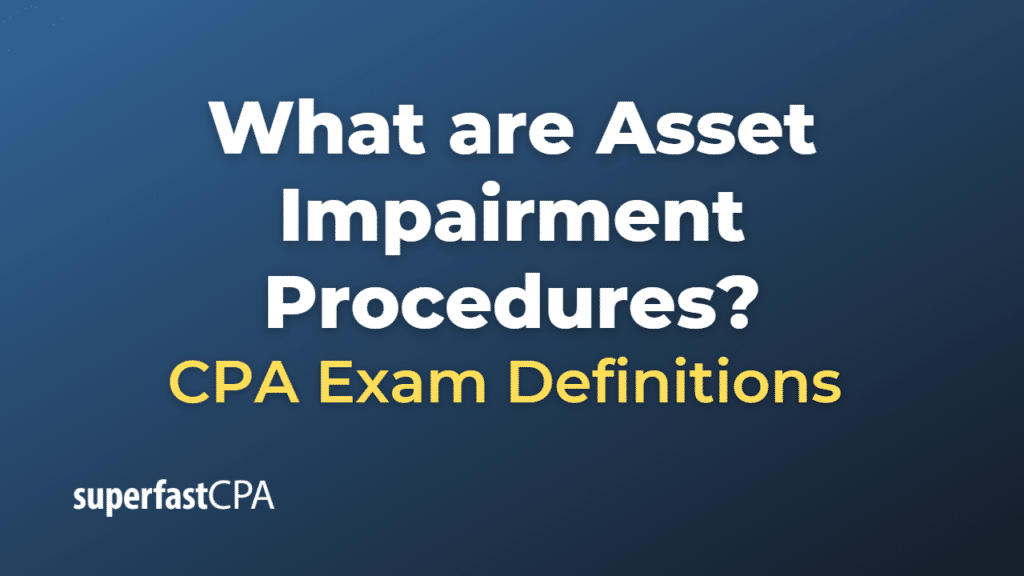Asset Impairment Procedures
Asset Impairment Procedures refer to the accounting process of evaluating and recognizing when an asset’s carrying value (book value) is greater than its recoverable amount. The recoverable amount is the higher of an asset’s fair value less costs to sell and its value in use. When an asset’s carrying value is higher than its recoverable amount, an impairment loss is recognized, and the asset’s carrying value is reduced to its recoverable amount.
The following steps outline the asset impairment procedures:
- Identify indicators of impairment: Look for internal or external factors that might indicate a decline in the asset’s value, such as market changes, technological advancements, or deterioration in the asset’s physical condition.
- Determine the asset’s recoverable amount: Calculate the asset’s fair value less costs to sell and its value in use. The recoverable amount is the higher of these two values.
- Compare carrying value and recoverable amount: If the carrying value is greater than the recoverable amount, an impairment loss should be recognized.
- Recognize the impairment loss: Record the impairment loss in the income statement, and reduce the carrying value of the asset to its recoverable amount on the balance sheet.
- Allocate the impairment loss: If the impaired asset is part of a larger group of assets, the impairment loss should be allocated to the individual assets within that group on a pro-rata basis.
- Reversal of impairment loss: In some cases, a previously recognized impairment loss may need to be reversed if there is a subsequent increase in the recoverable amount of the asset. However, the reversal should not cause the asset’s carrying value to exceed its original carrying value before the impairment loss was recognized.
By following these asset impairment procedures, companies can ensure that their financial statements accurately reflect the current value of their assets and provide a true and fair view of their financial position.
Example of Asset Impairment Procedures
Let’s consider a hypothetical example to illustrate the asset impairment procedures.
Company ABC owns a machine with a carrying value (book value) of $100,000. Due to a rapid technological advancement in the industry, the machine has become obsolete, and its market value has declined significantly. The company suspects that the machine’s value may be impaired.
Step 1: Identify indicators of impairment The technological advancement in the industry and the machine’s obsolescence are indicators of potential impairment.
Step 2: Determine the asset’s recoverable amount Company ABC estimates the fair value of the machine to be $60,000, and the costs to sell the machine are $5,000. So, the fair value less costs to sell is $55,000 ($60,000 – $5,000). The company also estimates that the machine’s value in use is $50,000. Therefore, the recoverable amount is $55,000, which is the higher of the two values.
Step 3: Compare carrying value and recoverable amount The machine’s carrying value ($100,000) is greater than its recoverable amount ($55,000), indicating that an impairment loss should be recognized.
Step 4: Recognize the impairment loss Company ABC records an impairment loss of $45,000 ($100,000 – $55,000) in the income statement and reduces the carrying value of the machine to $55,000 on the balance sheet.
Step 5: Allocate the impairment loss In this case, the impairment loss is related to a single asset, so no allocation among other assets is required.
Step 6: Reversal of impairment loss If, in the future, the recoverable amount of the machine increases, the company may need to reverse the previously recognized impairment loss. However, the reversal should not cause the machine’s carrying value to exceed its original carrying value ($100,000) before the impairment loss was recognized.
This example illustrates how Company ABC followed the asset impairment procedures to identify, measure, and recognize the impairment loss, ensuring that the financial statements accurately reflect the current value of the machine.













